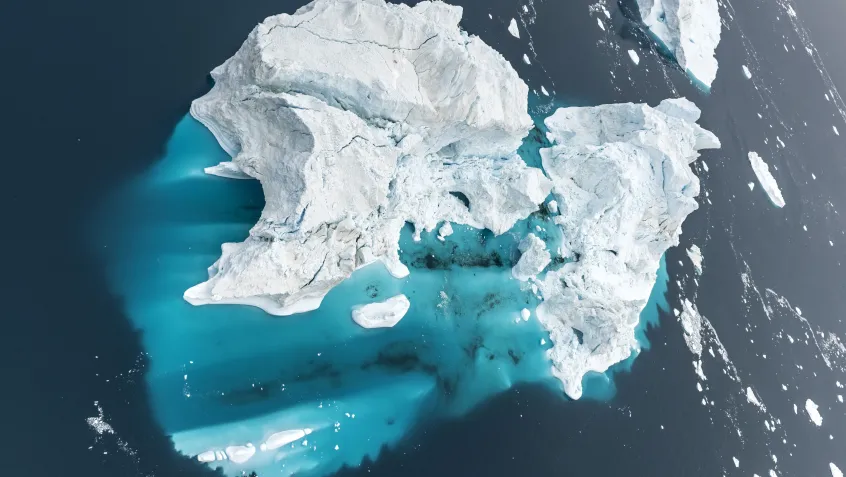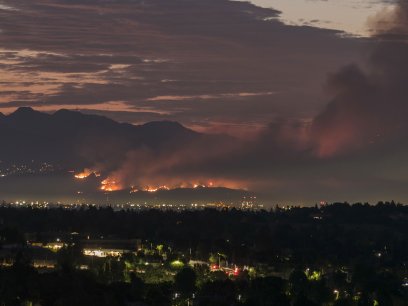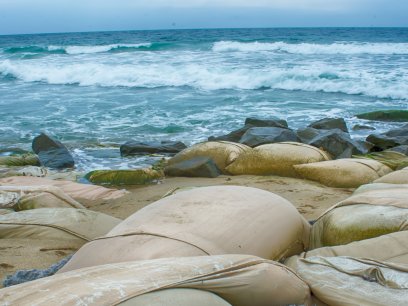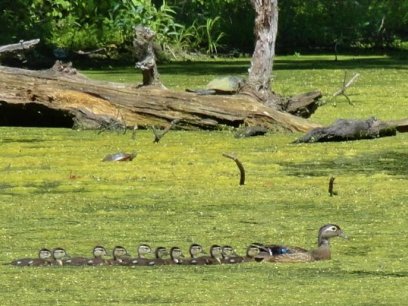
Did you know?
- September 2012 had the lowest Arctic ice cover on record? 49% below the 1979-2000 average.
- All months have shown a decreasing trend in Arctic sea ice cover over the past several decades.
Both land and sea ice cover in the Arctic have decreased since the late 1970s and the trend is expected to increase in the future due to a changing climate. The March 2019 Arctic sea ice annual maximum tied 2007 for the seventh lowest on record and the September 2019 Arctic sea ice annual minimum tied 2007 and 2016 for the second lowest in the satellite record.
Arctic sea ice is frozen seawater that floats above the Arctic Ocean – it plays an important role in regulating the planet's temperature. Snow and ice reflect solar energy back into space, whereas dark ocean waters absorb it. As more ice melts due to warmer air temperatures, the oceans are able to absorb more energy and heat. In turn, the warmer oceans increase ice melt and air temperatures in the Arctic, and influence atmospheric circulation and precipitation patterns in the Arctic and beyond.
The decrease in sea ice also affects many Arctic marine mammals, including whales, seals, walruses and polar bears that rely on the ice to live, feed and breed. Many species of seals use the sea ice to give birth and nurse their young during the spring, and polar bears use sea ice for feeding in late to early winter.
Learn More
- The NASA video below uses satellite imagery to show how Arctic sea ice has decreased since 1979.
- The NASA video below explains how Arctic sea ice thickness is measured and monitored.
What you can do
- Save money, improve your health, and take advantage of the cooler fall weather by going car free or car-lite when possible. Instead, try increasing them amount biking, walking, using public transportation, and/or carpooling you do.
Sources:
- Melillo, Jerry M., Terese (T.C.) Richmond, and Gary W. Yohe, Eds. 2014. Climate Change Impacts in the United States: The Third National Climate Assessment. Washington: U.S. Global Change Research Program. http://nca2014.globalchange.gov/.
- NASA. 2019. "2019 Arctic Sea Ice Minimum Tied for Second Lowest On Record." Accessed September 26, 2019. https://www.nasa.gov/feature/goddard/2019-arctic-sea-ice-extent-fourth-lowest-on-record
- NASA. 2018. "Arctic Wintertime Sea Ice Extent Is Among Lowest On Record." Accessed September 25, 2018. https://www.nasa.gov/feature/goddard/2018/arctic-wintertime-sea-ice-ext…
- NASA. 2016. "2016 Arctic Sea Ice Wintertime Extent Hits Another Record Low." Accessed September 26. http://www.nasa.gov/feature/goddard/2016/2016-arctic-sea-ice-wintertime…
- NASA. 2016. "Arctic Sea Ice Annual Minimum Ties Second Lowest on Record." Accessed September 26. http://www.nasa.gov/feature/goddard/2016/arctic-sea-ice-annual-minimum-…;
- NASA. 2015. "Impacts of a warming Arctic." Accessed September 30. http://climate.nasa.gov/resources/education/pbs_modules/lesson2Engage/.
- NASA. 2015. "Longer melt season a game changer for Arctic mammals." Accessed September 30. http://climate.nasa.gov/news/2279/.
- NSIDC. 2017. "Arctic Sea Ice Maximum at Record Low for Third Straight Year." Accessed September 19. http://nsidc.org/arcticseaicenews/2017/03/arctic-sea-ice-maximum-at-rec…
- NSIDC. 2019. "Arctic sea ice maximum ties for seventh lowest in satellite record". Accessed September 26, 2019. http://nsidc.org/arcticseaicenews/2019/03/
- NSIDC. 2018. "Nearing the Arctic's Seasonal Minimum." Accessed September 25. http://nsidc.org/arcticseaicenews/2018/09/nearing-the-arctics-seasonal-…
- US EPA. 2015. "Climate Change Indicators: Arctic Sea Ice." Accessed September 30. http://www3.epa.gov/climatechange/science/indicators/snow-ice/sea-ice.h….


